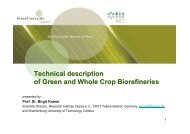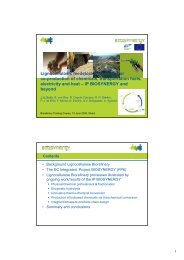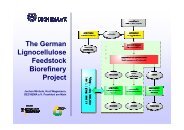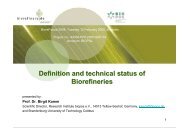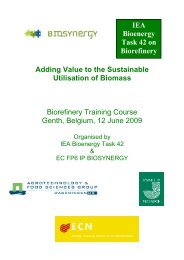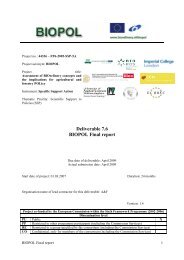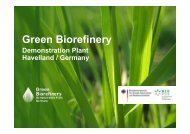Status Report Biorefinery 2007 - Wageningen UR E-depot
Status Report Biorefinery 2007 - Wageningen UR E-depot
Status Report Biorefinery 2007 - Wageningen UR E-depot
You also want an ePaper? Increase the reach of your titles
YUMPU automatically turns print PDFs into web optimized ePapers that Google loves.
CanadaCanada sees <strong>Biorefinery</strong> opportunities for the Canadian pulp and paper industry (Towers,et al.,<strong>2007</strong>). Three important research topics are: feedstocks, conversion and separation technologiesand markets for products. A list of proposed research activities mainly on the LCFBR type ofbiorefinery in connection with the traditional pulp & paper industry is given in Table 13.Table 13 Proposed research activities in Canada (Towers, et al., <strong>2007</strong>).TitleProduct opportunity analysisAvailability of forestfeedstocksThermochemical pathwaysBioproducts from effluentand solid wastesProducts from hemicelluloseProducts from ligninProducts from extractivesProducts from condensatesPhytochemicalsIntegrating novel productswith existing product linesConversion of uncompetitivemillsIntegration with otherindustriesDescriptionMarket analysis; high value vs high volume productsAvailable biomass (forest, sawmill, pulp mill, agricultural or otherresidues): costs, logistics, etc.Gasification and pyrolysis pathways to novel productsBio-degradable plastics; products from anaerobic treatment systems;value-added uses of sludgesExtract fuels and specialty chemicals while maintaining pulp propertiesExtraction of lignin from Kraft black liquor, and its use in novelproductsSynthetic diesel and other products from crude tall oilMethanol extraction, purification, and transformation processesNovel high value, low volume products from bark, branches and foliageMaintaining pulp and paper properties while modifying existing mills fornovel productsIdentifying new uses for idled Kraft production lines, in particular batchpulping systemsIdentify synergies with commercial, industrial or domestic neighboursCanadian Triticale <strong>Biorefinery</strong> InitiativeAn R&D Network focussed on developing triticale, a high yielding non-food cereal crop, as abiorefinery feedstock for the manufacture of fuels, chemicals, and materials (Phillips, <strong>2007</strong>).Canadian Forest BiorefineriesA forest biorefinery will use multiple feedstocks, including harvesting residues, extracts fromeffluents, and fractions of pulping liquors, to produce fibre, energy, chemicals, and materials. In2006, a Technology Roadmap for Canadian Forest Biorefineries was developed (MSS, 2006).<strong>Status</strong> <strong>Report</strong> <strong>Biorefinery</strong> <strong>2007</strong> 53





